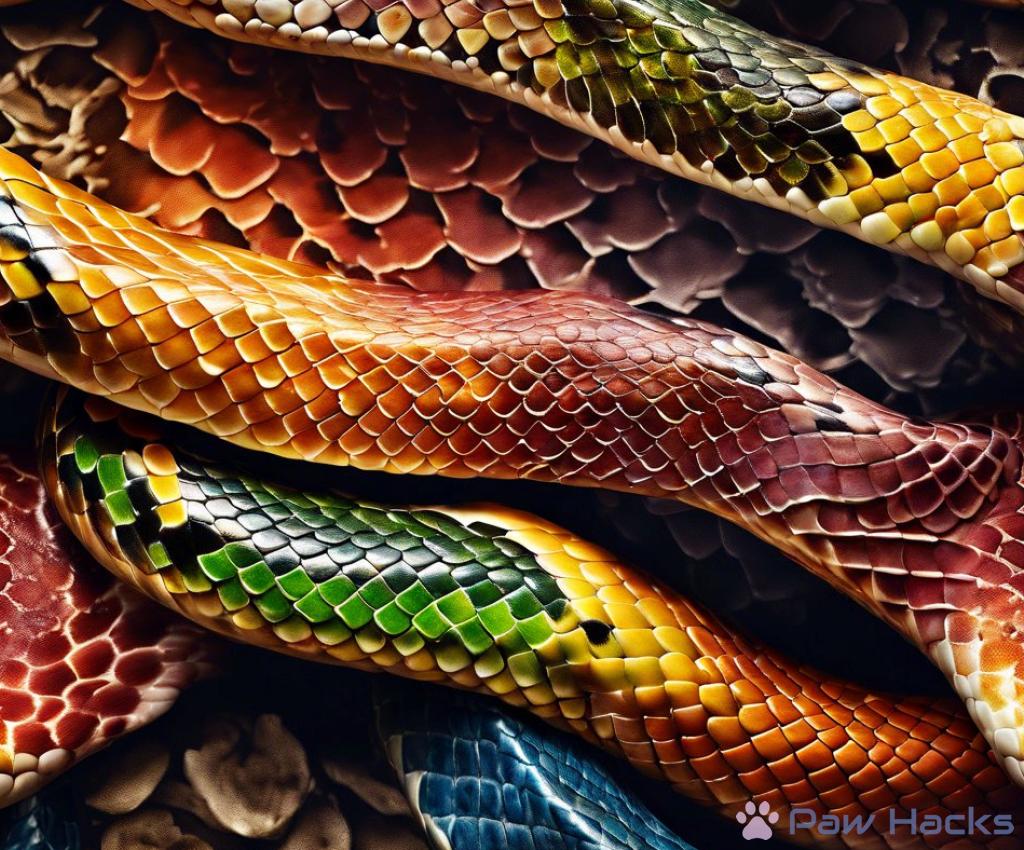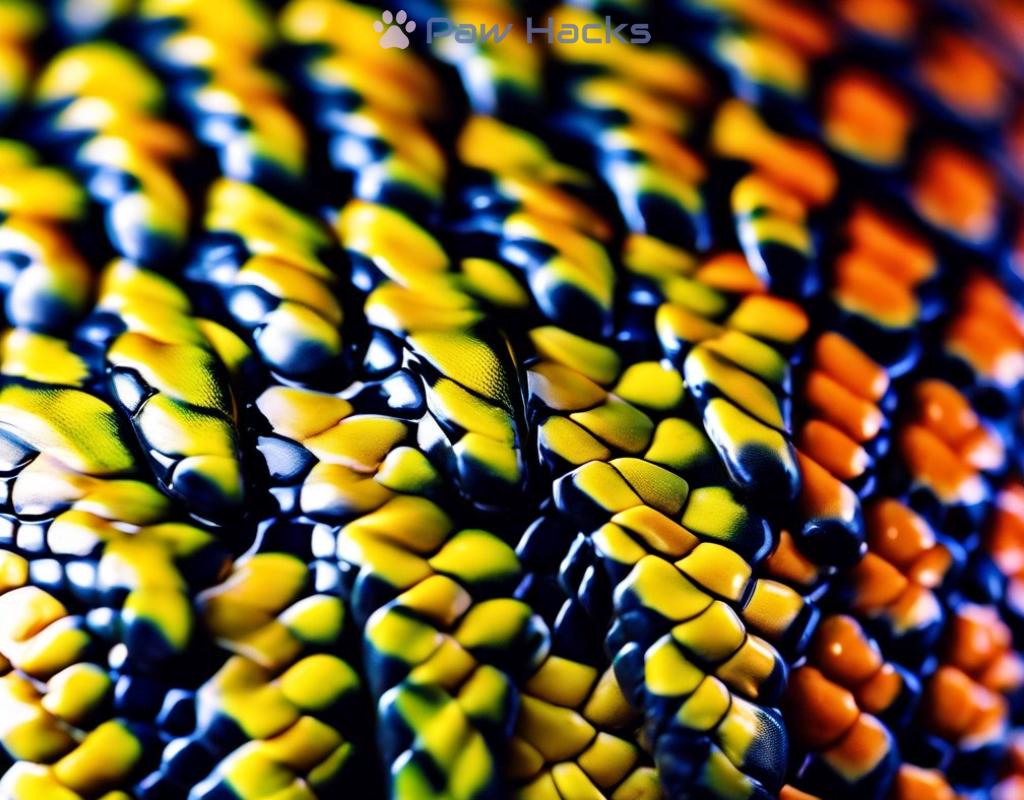Maintaining Healthy Scales in Snakes
Essential Nutrients for Vibrant Snake Skin

The Importance of Proper Nutrition
A snake’s skin is not just its outer covering; it’s a vital part of its health and well-being. To maintain vibrant scales that reflect the snake’s overall vitality, it’s essential to provide the right nutrients. This article explores the essential nutrients that contribute to healthy snake skin, ensuring your scaly friend looks its best.
Key Nutrients for Resilient Skin
Just like humans, snakes require a balanced diet that includes various nutrients to support their skin health. Below is a list of essential nutrients that play a crucial role in maintaining vibrant and resilient scales:
- Proteins: Essential for skin regeneration and repair.
- Vitamin A: Critical for skin development and maintaining moisture.
- Omega-3 Fatty Acids: Help reduce inflammation and support skin elasticity.
- Calcium: Vital for the formation of scales and overall skeletal health.
- Zinc: Important for healing and maintaining skin integrity.
Feeding Strategies for Optimal Skin Health
To ensure that your snake receives these essential nutrients, consider the following feeding strategies:
- Variety is Key: Offer a range of prey items, including rodents, insects, and other appropriate foods.
- Supplement Wisely: Use reptile-specific supplements that contain vitamins and minerals when necessary.
- Monitor Hydration: Ensure your snake has access to fresh water, as hydration is crucial for skin health.
By understanding the importance of these nutrients and implementing effective feeding strategies, you’ll be well on your way to ensuring your snake maintains vibrant and healthy scales.
The Role of Humidity in Scale Health: A Snake’s Perspective

Understanding Humidity and Its Impact
For snakes, humidity levels in their environment are as critical as the nutrients they consume. These creatures thrive in specific humidity ranges that influence their overall scale health and well-being. Too much or too little humidity can lead to various skin issues, including shedding problems and dryness. This section delves into the significance of maintaining optimal humidity for your scaly companions.
Humidity Levels: The Balancing Act
Finding the right humidity balance is essential for snakes, as it directly affects their ability to shed skin properly. Snakes typically require humidity levels between 30% to 70%, depending on the species. Below is a brief overview of how varying humidity levels can impact snake health:
- Low Humidity (<30%): Can lead to dehydration, resulting in dry, flaky skin and difficulty shedding.
- Optimal Humidity (30%-70%): Promotes healthy skin and facilitates seamless shedding cycles.
- High Humidity (>70%): May cause respiratory issues and promote the growth of mold or bacteria, affecting skin integrity.
Tips for Maintaining Ideal Humidity
To ensure your snake enjoys a comfortable and healthy environment, here are some effective strategies to maintain appropriate humidity levels:
- Use a Hygrometer: Invest in a good-quality hygrometer to monitor humidity levels accurately.
- Water Sources: Provide a shallow water dish that your snake can soak in, aiding in maintaining humidity levels.
- Regular Mistings: Lightly mist the enclosure with water, especially during shedding periods, to boost humidity without over-saturating the substrate.
- Substrate Choice: Utilize substrates that retain moisture well, such as coconut fiber or sphagnum moss.
By understanding the vital role humidity plays in your snake’s scale health and taking proactive measures to regulate it, you can help ensure that your companion remains vibrant and healthy.
Signs of Scale Problems: What Every Snake Owner Should Know
Being a responsible snake owner involves vigilance and understanding the signs that may indicate scale problems. Just like any other pet, snakes communicate their health status through their physical appearance. Scale issues can arise from various factors such as nutrition, humidity, and overall care. Recognizing these signs early can help prevent more serious health problems down the line.
Key Indicators of Scale Health Issues
When monitoring your snake, there are several key indicators that can alert you to potential scale problems. Understanding these signs will allow you to take swift action, ensuring your snake remains healthy and vibrant. Below, we present a list of common scale issues to look out for:
- Discoloration: Scales that appear dull, faded, or discolored may signal a lack of essential nutrients or poor hydration.
- Shedding Problems: If your snake consistently has retained shed or incomplete shedding, it may indicate improper humidity levels.
- Scales Lifting or Peeling: Scales that are lifting or peeling away from the skin could be a sign of infection or a more serious health issue.
- Rough or Bumpy Texture: Scales that feel rough or exhibit bumps may indicate underlying health problems, including skin infections.
- Excessive Shedding: Frequent shedding without visible growth can indicate stress or nutritional deficiencies.
Understanding the Underlying Causes
Once you’ve identified potential scale problems, it’s essential to understand the underlying causes. Various factors contribute to the health of your snake’s scales, and addressing these can help restore their vibrancy:
| Issue | Possible Cause | Recommended Action |
|---|---|---|
| Discoloration | Nutritional Deficiency | Adjust diet to include a variety of prey and supplements. |
| Shedding Problems | Improper Humidity | Monitor and adjust humidity levels; mist if necessary. |
| Lifting Scales | Infection or Injury | Consult a veterinarian for treatment options. |
| Rough Texture | Skin Infection | Seek professional medical advice for diagnosis. |
| Excessive Shedding | Stress or Poor Diet | Evaluate environment and nutrition; reduce stressors. |
Taking Action for Scale Health
Once you’ve identified any scale problems and their potential causes, it’s crucial to take proactive measures. Regular veterinary check-ups, maintaining optimal habitat conditions, and ensuring a balanced diet are all key components of snake care. By staying informed and addressing issues promptly, you can help your snake maintain its splendid scales and overall health.
Bathing Your Snake: A Simple Guide to Scale Care
Understanding the Benefits of Bathing for Your Snake
Bathing your snake is not just a luxury; it’s a vital aspect of maintaining their overall skin health. Just like humans, snakes can benefit from regular bathing sessions, which help to keep their scales clean and free from debris. Additionally, bathing can assist in hydration and promote easier shedding, especially during periods when your snake is preparing to molt. This simple practice can significantly enhance your pet’s comfort and well-being.
How to Properly Bathe Your Snake
When it comes to bathing your snake, there are essential steps to follow to ensure safety and effectiveness. First, it’s crucial to choose the right environment. A shallow container filled with lukewarm water is ideal. Ensure the water is not too deep, as snakes can become stressed if they feel overwhelmed. During the bath, allow your snake to soak for about 15 to 20 minutes. This duration is sufficient to cleanse their scales and boost moisture levels without causing undue stress.
As you proceed, always keep a watchful eye on your snake. Gently handling them can help prevent any panic. Use this time to observe their scales closely; look for signs of health issues that may need attention. After bathing, it’s important to dry your snake gently with a soft towel before returning them to their enclosure. Be cautious and avoid using heat sources, as snakes can easily become overheated.
Integrating Bathing into Your Snake Care Routine
Incorporating bathing into your snake care routine can yield remarkable results. Consider establishing a bathing schedule based on your snake’s unique needs. For instance, during shedding periods, more frequent baths can aid in the shedding process, while regular baths can help maintain overall skin health. Remember, the key is to create a comfortable and stress-free bathing experience for your snake. By prioritizing this routine, you will not only keep your snake’s scales looking vibrant but also promote their overall health and happiness. So, take the plunge and make bathing a part of your snake care regimen!
Shedding: Understanding the Process and Its Importance for Healthy Scales
Shedding is a fascinating and essential process in the life of a snake, playing a crucial role in maintaining the vibrancy and health of their scales. Unlike mammals, snakes do not grow hair, and their skin is covered in scales that require periodic renewal. This article delves into the shedding process, explaining its significance and how it contributes to the overall well-being of your scaly companion.
The Shedding Cycle: A Natural Process
Shedding, or ecdysis, is a natural biological process that allows snakes to grow and maintain healthy skin. During this cycle, snakes will typically shed their old skin in one piece, revealing fresh, vibrant scales underneath. This process can occur several times a year, depending on the snake’s age, species, and environmental conditions. Understanding the phases of shedding can help snake owners recognize when their pets are about to shed and how to support them during this time.
Signs Your Snake is Ready to Shed
As a responsible snake owner, it’s vital to recognize the signs that indicate your snake is preparing to shed. By being aware of these indicators, you can provide the necessary environment and care to facilitate a smooth shedding process. Here are some common signs:
- Cloudy Eyes: One of the first signs of impending shedding is the appearance of cloudy or bluish eyes, which indicates that the old skin is loosening.
- Decreased Appetite: Many snakes will eat less or stop eating altogether as they prepare to shed, focusing their energy on the shedding process.
- Increased Hiding Behavior: Snakes may seek shelter or hide more often during this period, as they tend to feel vulnerable.
- Skin Color Changes: The scales may appear dull or faded, signaling that the old skin is ready to be shed.
Caring for Your Snake During Shedding
Supporting your snake during the shedding process is crucial for maintaining healthy scales. Here are some effective strategies to assist your pet:
- Maintain Optimal Humidity: Ensure humidity levels are appropriate to facilitate easy shedding. A humidity range of 50% to 70% is often ideal.
- Provide Soaking Opportunities: Offering a shallow dish of water or misting the enclosure can help keep the skin hydrated, making it easier for your snake to shed.
- Avoid Handling: Limit handling during this time, as snakes may feel stressed or uncomfortable while shedding.
By understanding the shedding process and its significance, snake owners can better appreciate the importance of maintaining healthy scales. This natural cycle not only allows snakes to grow but also keeps their skin in optimal condition. With the right care and attention, you can ensure your snake experiences a successful shedding process, promoting vibrant and healthy scales.
Share this content:



